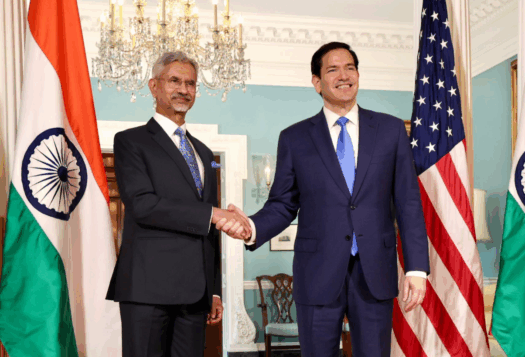
The Indian Cabinet recently approved the Indian Space Policy, which institutionalized and clarified the private sector’s role in the space sector. Under the policy, private space companies now can perform end-to-end space activities, build spaceports and mobile launch platforms, and provide services nationally and internationally in communication, remote sensing, and navigation. While the policy aims to boost India’s space-based innovation and capabilities, technological advancements made through public-private partnerships risk disturbing South Asia’s delicate security balance.
As a rising power, India seeks to expand its capabilities to match with other great powers, including the United States and China. However, the dual-use potential carries security risks, particularly to the India-Pakistan rivalry. While the Indian private sector will continue to be involved in commercial and military actions in space, efforts to enhance India-Pakistan deterrence stability can be explored through clearly separating commercial and military applications. The separation of commercial and military use could be achieved through the establishment of international agreements restricting the militarization of space, confidence-building measures (CBMs), verification and monitoring, and developing best norms and practices.
While the Indian private sector will continue to be involved in commercial and military actions in space, efforts to enhance India-Pakistan deterrence stability can be explored through clearly separating commercial and military applications.
Indian Private Players in Space
Private sector companies’ enhanced role in space exploration extends beyond India. The United States and China have already shown a willingness to use commercial space entities for national security purposes. China encourages its private entities to participate in space activities, and is a part of the Civilian-Military Integration Strategy (MCI). The United States Space Priority Framework also outlines how new commercial space capabilities and services can be used to meet national security needs. In a 2021 interview, the head of the U.S. Space Force discussed leveraging the advantages of the space industry for national security.
The leading companies of the Indian Space Association (IsPA) are already working closely with the Indian Defense Ministry in different contracts, suggesting that India may also follow the same path. The IsPA leadership also has a close connection with the Indian army and Indian defense organizations. For instance, the first chairman, Jayant Patil, is the senior vice president of Defense, Larsen and Toubro Group. L&T has been associated with the Defense Research & Development Organization (DRDO) since the mid-1980s.
In 2021, the Indian Government launched IsPA to conduct space activities such as constructing satellites, launch pads, and rockets that can carry out data collection and data dissemination. A number of notable Indian private companies, including Larsen and Toubro, Nelco (Tata Group), and Mapmy India are founding members of this organization.
In April 2023, the Chief of Defense Staff specified the role of private companies in augmenting Indian defense capabilities. He said, “As seen during the Russia-Ukraine conflict, SpaceX and Maxar had unfolded a new area in the war on convergence… This, combined with the intense race towards militarization of space, has expanded the battlespace and the very nature of warfare is at a major cusp of transformation.” India’s 2023 space policy demonstrates the government’s efforts to integrate the role of the private sector in civilian and defense capabilities.
While public-private partnerships stand to bolster India’s space-based capabilities, these technologies pose a risk to stability vis-à-vis Pakistan. Widening asymmetries between India and Pakistan could weaken deterrence and fuel regional instability. While New Delhi’s push towards acquiring new space-based capabilities is all but guaranteed, measures are required to preserve strategic stability in South Asia.
Dual-Use Technologies
India already has a well-developed space program, which has launched 422 satellites off 34 different countries as of March 2023. However, it does not match China’s sophisticated missile systems. Recently, leaked intelligence showed that China has tested and deployed a new hypersonic missile that might evade U.S. defenses. To close the capabilities gap, India seeks to use public-private cooperation to upgrade its missile defense system. The military is also exploring ways to increase the capability of its remote sensing satellites. Satellites can improve the precision of short-to medium-range ballistic missiles to 20-25 percent and the precision of advanced ballistic missiles to 70 percent where it could only analyze large structures like aircraft hangers. While Indian remote sensing capability is increasing, collaborating with commercial firms could accelerate these efforts.
India currently has at least six satellites to capture images with a resolution of 0.6 to 1 meters. India also attempted to launch the GISAT 1 satellite, but failed to launch the satellite in orbit. Commercial satellites can help India improve its remote sensing and reconnaissance capabilities and aid in counterforce doctrines. Hughes Communication India, a founding member of the IsPA, is already working on providing satellite system integration projects for the Indian Army, navy, and air forces.

Strategic Advantages vis-à-vis Pakistan
While collaboration between the Indian Defense Ministry and new commercial firms is intended to close gaps with China, India’s counterforce capabilities against Pakistan will inadvertently be strengthened. Widening technological gaps between India and Pakistan could increase threat perceptions in Rawalpindi. Pakistan’s deployment of assets and force could become vulnerable and its element of surprise and the ability to retaliate are removed. With factors such as the inclusion of the S-400 missile defense system, uncertainty about India’s No First Use Policy, the inclusion of new missiles such as the Agni-P missile, the potential of increased Indian reconnaissance capabilities will be in the minds of military planners of Pakistan.
The multipurpose nature of satellites gives India an edge over Pakistan in the event of war. India can use these satellite networks to undermine Pakistan’s defense by obtaining high-resolution imagery, gathering valuable intelligence, navigation, and military communication. These satellites can also help develop early warning systems to detect ICBMs in their different flight phases and cruise and ballistic missiles. In addition, space tools have become an integral part of modern warfare. Satellites have become a strategic tool that are essential to winning war, and Indian space capabilities far exceed those of Pakistan.
Implications on Regional Stability and the Road Ahead
Pakistan expressed grave concerns after India tested its anti-satellite space weapon test and said that the Indian test has made it impossible to use space for peaceful purposes. While Pakistan may seek to improve deterrence by investing in its own defense capabilities, the cost of advancement may prove prohibitive, particularly in the country current economic climate. Instead, both India and Pakistan should prioritize confidence building measures to maintain strategic stability.
Sustained communication and dialogue help Pakistan and India build mutual trust between the two nations. There is a need for a regular communication channel, such as a hotline between space agencies of two countries or relevant institutions, for information sharing. Both countries could create a crisis communication channel for emerging technology if some incident related to dual-technologies happens. Pakistan and India can also have an informal agreement on dual-use technologies.
Pakistan and India can also consider signing treaties or bilateral agreements related to space activities. These agreements and treaties can have provisions that ensure information sharing on satellite launches and notify each other about space-related activities, promoting transparency in space programs. In addition, both countries can promote confidence-building measures by sharing data about orbital parameters and space debris mitigation measures. This can help both countries in reducing suspicion and intentions behind space activities. On similar lines, bilateral agreements and treaties can be signed to promote transparency in the use of dual-use technologies. These agreements can help in preventing miscalculations and misinterpretations.
There are existing, though vague, agreements from the Cold War protecting against the militarization of space – the nuance mostly comes in what militarization entails, which is yet to be defined and states currently see advantage in the ambiguity.
Both Pakistan and India can engage in regional and international forums to discuss space and dual-use technologies security issue, exchange best practices, and promote norms of responsible behavior in space. Participation in initiatives such as the United Nations Committee on Peaceful Uses of Outer Space (UNCOPOUS).
Third parties can facilitate Track II dialogues involving non-governmental actors, experts, and scholars to discuss security issues and propose recommendations. These dialogues can foster greater understanding, provide alternative perspectives, and generate innovative ideas to help policymakers. Track 1.5 dialogues can also be explored to understand each other’s point of view.
Online collaboration networks or virtual research network platforms could be established to connect researchers and scientists from Pakistan and India. These networks can facilitate remote data sharing, collaboration, and joint publications on emerging technologies. Third parties should play a role in resuming dialogue between two countries. The United States has shown willingness in the past to facilitate dialogue between two countries if they agree.
Pakistan should urge the international community to ensure that commercial space capabilities are not used for military purposes. However, their use will not be limited to India. Other countries, including China and the United States, discuss utilizing commercial satellites for military purposes. There are existing, though vague, agreements from the Cold War protecting against the militarization of space – the nuance mostly comes in what militarization entails, which is yet to be defined and states currently see advantage in the ambiguity.
The utilization of dual-use technologies could trigger a space-based arms race, leading to increased military spending, escalating tensions, and a heightened threat of war. To address these concerns and foster an atmosphere of trust, Pakistan and India must explore various confidence-building measures. To do so, both countries should first start bilateral dialogue focused on the security of space. Secondly, both countries can exchange information on space activities and dual use technologies. Furthermore, international agreements such as the Outer Space Treaty and the Prevention of an Arms Race in Outer Space (PAROS) treaty can provide a valuable framework for both countries to mitigate risks associated with the militarization of space. Both countries can engage in discussions and adhere to international norms to ensure peaceful and responsible use of space assets while reducing the likelihood of conflict in the region.
Also Read: Strategic Ambiguity in Indian Outer Space Policy
***
Image 1: India-Pakistan Borderlands via Wikimedia Commons
Image 2: ISRO via Wikimedia Commons


